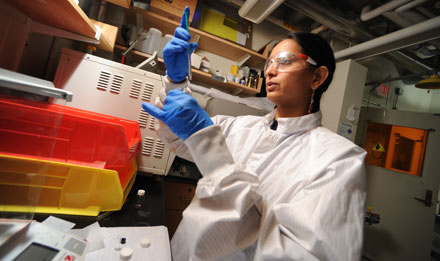
RLE: Where the Future Begins
The Research Laboratory of Electronics (RLE) at the Massachusetts Institute of Technology (MIT) was the first of the Institute’s great modern interdepartmental academic research centers. Today, we are one of MIT’s largest such organizations, and the most diverse research laboratory at MIT in our scope of intellectual interests.
Research in RLE encompasses an extensive range of natural and man-made phenomena, and our projects are both basic and applied. Common among all RLE efforts is an expansive 21st century interpretation of the 20th century term “electronics,” starting at the most basic physical realm of particles and quantum physics and extending all the way to sophisticated engineering application technologies relevant to today and critical to tomorrow.
Major Research Themes
Research in RLE today is focused on seven major themes:
- Atomic Physics
- Information Science and Systems
- Quantum Computation and Communication
- Energy, Power and Electromagnetics
- Photonic Materials Devices and Systems
- Nanoscale Materials, Devices and Systems
- Biomedical Science and Engineering
A Nexus of Multidisciplinary Activities
Seventy-two principal investigators in RLE—of whom sixty-four are members of the MIT faculty—direct the Laboratory’s research projects. Our professors reflect the Laboratory’s diverse scope of intellectual interests, and are drawn from nine MIT academic departments and divisions:
- Biological Engineering Division
- Department of Electrical Engineering and Computer Science
- Department of Materials Science and Engineering
- Department of Mathematics
- Department of Mechanical Engineering
- Department of Nuclear Science and Engineering
- Department of Physics
- Engineering Systems Division
- Harvard-MIT Division of Health Sciences and Technology
Over three hundred MIT graduate and undergraduate students—also drawn from the MIT departments and divisions above—make RLE one of the primary environments for student learning at MIT. In fact, it is this combination of forefront research with student participation across multiple academic disciplines that characterize the RLE culture.
Sponsorship and Collaboration
The wide range of RLE research efforts are supported by the most diverse sponsor base at MIT. Principal sponsors of RLE research include:
- The Department of Defense (DOD)
- The National Institutes of Health (NIH)
- The National Science Foundation (NSF)
- Industry
- Non-profit foundations and organizations
Moreover, a significant share of RLE activities is self-funded from gifts and from the discretionary resources of the Laboratory and its principal investigators.
Approximately a third of RLE’s activities involve collaborations outside of MIT with universities, institutions, and industry, making RLE one of the principal points of MIT connection with peer institutions, government, and the business world.
Leadership
The Director of RLE is Marc Baldo, Professor of Electrical Engineering, and Director, Center for Excitonics.
The Associate Directors of RLE are Yoel Fink, Professor of Electrical Engineering and Professor of Materials Science, and Wolfgang Ketterle, John D. MacArthur Professor of Physics and Director, Center for Ultracold Atoms.
The Assistant Directors of RLE are David W. Foss (Information Technology Services) and Richard A. Petruzzelli (Administration and Human Resources.)
Location and Facilities
Nearly all RLE activities take place at the MIT main campus in Cambridge, Massachusetts. Core RLE research facilities and offices are located in the Fairchild Complex (MIT buildings 36 and 38), the Compton Laboratories (MIT building 26), and the Maclaurin Buildings (MIT building 10.) RLE Headquarters and the office of the Director are in building 36. RLE principal investigators also have offices and laboratories in other MIT locations, including MIT buildings 3, 12, and 13, and off-campus at the Massachusetts Eye and Ear Infirmary in Boston, Massachusetts.
